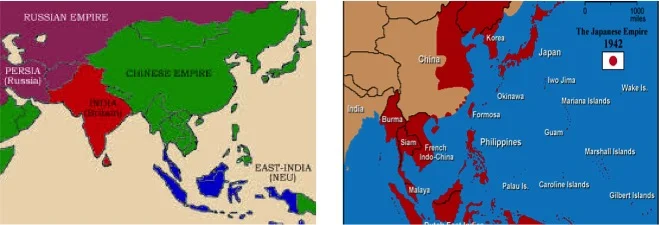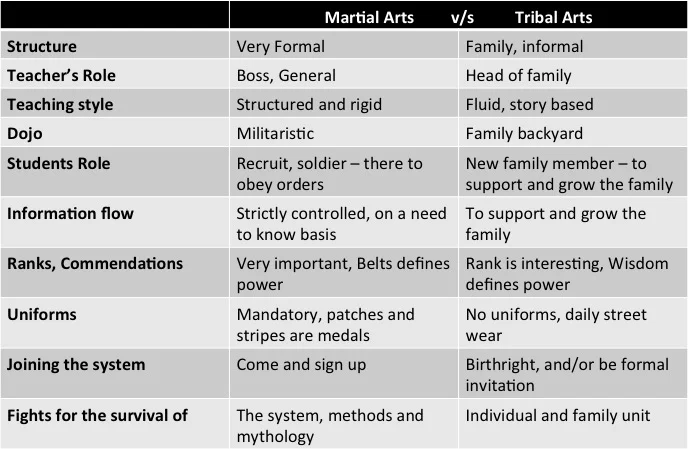“Stop being so formal, you are not learning a militaristic art. Learning a tribal art it is like having a BBQ with your favorite uncle while exchanging stories!” exclaimed James Keating, the Master At Arms as he continued teaching “You dont have to yes sir me to death, I dont own you. We share here like family and you just call me Uncle Jim."
I had spent over two decades in the Martial Arts but this distintion between Martial and Tribal Arts had always eluded me. And yet that cold day in February it forever changed how I understood the fighting arts. The two approaches are as different as oil and water and yet there is no real literature on this distintion. A friend (@ChrisNelly) encouraged me to write about it and make this more clear to all who may read. I will push the two distinctions to their limits to drive home the point.
(Empires framed and developed the Military expressions of fighting)
Martial Arts have mostly emerged from kingdoms and large military cultures such as China and Japan. There is a very strong Confucian strand that runs through it - whereby the prime duty of the ruler is “impose order onto chaos.” To do this the ruler needed his soldiers to impose his rules without question. You hear words like rules, traditions, chain of command, rank, procedure etc. In short it is a very Yang and Patriarchal expression.
This environment shaped the Martial Arts for organized war. The systems were strictly encoded and formalized. There was rigid adherence to following a specific process of learning. Information and learning is highly compartmentalized - on a need to know basis. The instructor is the drill sergeant screaming you into shape, so that you can someday prove to be a worthwhile soldier for the Kingdom/General/Shogun/Soke to use as s/he will. When you stayed loyal to the superiors, you got medals or more stripes on your belt. This proved you were now a more valuable member of the platoon. You get the idea.
The weapons evolved to allow mass production and their only purpose is killing. The formations and movement patterns dictated how the weapons would be wielded - laying the foundation of war strategy or school methods/ryu ha in Japanese Arts. The goal of the weapons and strategy is victory at all costs, and collateral damage happens all the time.
Martial Arts is the mass mind at work. It does not value individuality and comes down hard on any rebellion. The system or idea needs to survive at all costs.
Now Tribal Arts emerged in all over South Asia, SE Asia and Africa. The kingdoms were small, scattered, never really unified under one mightly emperor for long. The alligence to blood and friends is what matters most. The arts were honed and used for survival of the family unit. Memebrs of the family got together in secret to teach each other what worked and to invent new ways of doing things. Most tribes were also Animistic (Wikipedia defines it as a belief system where there is "no separation between the spiritual and physical (or material) world, and souls or spirits exist, not only in humans, but also in some other animals, plants, rocks, geographic features such as mountains or rivers, or other entities of the natural environment.”)
The tribal arts are seldom formalized. Most teaching happens as a way of life - where every moment is a learning moment. There is a reverence for nature and its elements, and they teach too. There are no trophies or honors bestowed, your skill is justly acknowledged by the tribe. You learn to fight to ensure the survival of your family unit - therefor it is very personal. The techniques don’t look pretty or awe inspiring but are elegantly effective. They have evolved in the environment you live - therefore are well adapted to the enviornment.
The weapons used are tools one would use in everyday life, be it the machete in Mexico or sticks/Kris in the Philipines or oars/kama in Okinawa and the Polynesian islands. These weapons were tools that one would carry about doing their daily bidding.
Tribal Arts are usually individual minds at work. Your unique expression is what usually saved your family. The goal of the training is survival to thrive. These arts are comparatively Yin and Matriachial in nature. These methods are rapidly disappearing. The laughter of backyard training and dinners is being replaced by the mechanized mass mind - martial arts.
Both the arts and approaches have different advantages and disadvantages. For most effectiveness choose what suits your values and needs best.
If you are looking for traditions to belong to, discipline, a hard driving teacher, tested methods and feedback through ranks then go down the path of formal Martial Arts as exemplified by established schools of Karate, Kung Fu, Muay Thai etc.
If you are interested in sheer effectiveness, a community to belong to, an elder as teacher and feedback in form of teaching stories then go down the path of tribal arts as exemplified by small family and village arts from the Philippines, Java, Kerala(India) and Africa. These are much harder to come by and even harder to be accepted into.
Whatever you choose, keep this distinction in mind and it will enrich how you interact with other arts. Together they will richly inform your martial education.
Until next time,
Mahipal Lunia, Sensei
www.MountainViewAiki.com
www.TheRenaissancePath.com
www.RadicalChangeGroup.com



